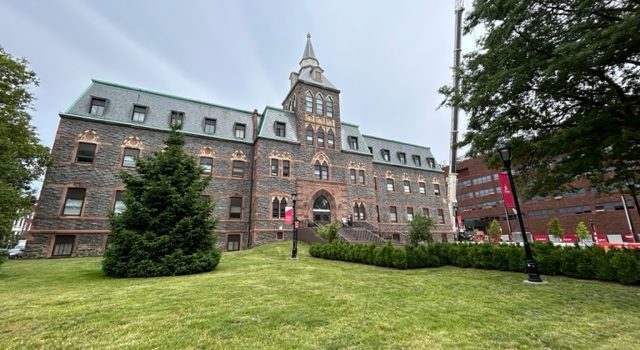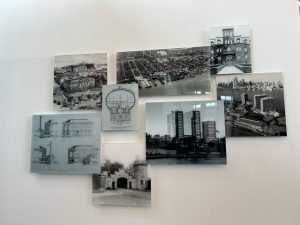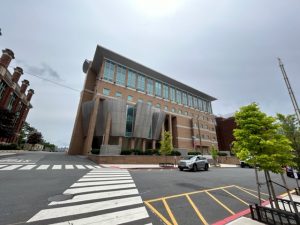Getting To Know: Stevens Institute of Technology (NJ)-Again
Stevens Institute of Technology has grown its academic programs, student body and housing options since my first visit nine years ago After attending a virtual counselor’s briefing at the beginning of June, I signed up for a tour and information session to learn more. I also updated my Stevens Pinterest page for you. I must also express thanks to April Chang, Dean of Admissions, for allowing me to take a visit only the day before I came and for being generous with her time. She is one of the nicest people that I have met in the admissions world.
Stevens Institute of Technology is quite close to Manhattan, but lacks brand recognition.
The institute is not as geographically diverse as Cal Tech, MIT or even Lehigh. Less than 40 percent of the undergraduate population comes from outside New Jersey, though the institute offers much to appeal to students from anywhere.. When you see the historical timeline of the Institute and exhibits in the admissions office (below), you might be surprised by Stevens’ contributions to America’s economic and scientific growth.
Notable alumni are as prominent as they are from schools such as Lehigh, Rensselaer Polytechnic Institute (RPI) or Worcester Polytechnic Institute (WPI). While over 36,000 Stevens alumni registered in LinkedIn.com are based in ou near New York City and nearly 29,000 are in the Garden State, there are also over 2,800 in California. There are also fairly large communities around Philadelphia and Washington DC.
Stevens is quite proud of its return on investment.
The outcomes report shows that the school delivers on that measure. Career services are excellent. However, the direct charges (tuition, fees, room & board) are approximately $79,000 for the upcoming academic year. About a third of the class that entered last year received merit scholarships that averaged over $23,000. But the school met, on average, less than 75 percent of need. The average student loan debt among students in the Class of 2021 who borrowed was over $41,000.
You can go to schools that are far less expensive that also offer excellent career development services, especially in engineering and computer science. However, to be fair, they are likely to be much larger schools. Rutgers-New Brunswick has about the same number of students in the School of Engineering as Stevens has for all majors. But the educational experience will be less personal. If you have taken on a rigorous STEM workload and want a small, ultra-selective engineering school that costs significantly less than Stevens take a look at Cooper Union.
Stevens Institute of Technology is small but quite rigorous.
The institute has grown from 2,500 undergraduates when I visited in 2014 to nearly 4,100 today. Stevens students, aka Ducks, may have some large introductory classes in math or the sciences. But the institute has a lower percentage of classes with over 50 students (8 percent) than RPI (10 percent), WPI (12 percent) and MIT (10 percent).
Those who get in tend to stay. Ninety-three percent of the students who entered in 2021 returned for their sophomore year. Nearly two-thirds of the entering classes of 2019 and 2020 graduated in four years. Eighty-six percent of each class finished in five, possibly with more work experience than peers at other colleges or a masters degree..
Stevens offers 39 majors. Most are also minors.
While Stevens offers liberal arts and business degrees, most majors have a science/technology orientation. Computer Science is the most popular undergraduate major at Stevens, attracting almost a fifth of the student body. But prospective students who are interested in computer science should closely check the catalog. While computer science is the most popular major, other degree programs offer the opportunity to combine computing with other interests. These interests include art, business, music and public policy, among others.
There are also business programs worth checking out. The accounting and marketing programs are more data driven than you might find at other business schools in the NJ/NYC area. Quantitative Finance, which blends economics, finance, mathematics, statistics and computer science, is the third most popular major at the institute. This high-demand and highly demanding undergraduate major is not available at Fordham, Rutgers-New Brunswick or NYU. Steven’s School of Systems and Enterprises offers several options that combine business with engineering principles and practices.
Be ready to dive right into major coursework.
Stevens Institute of Technology has only two course requirements that everyone must take in order to graduate. These are a freshman writing course and a First Year Experience seminar. Every incoming freshman is also given a laptop computer. Each of the four schools within Stevens has their own requirements in addition to those for the major. For example, Computer Science majors solve coding problems during their first year. Business students take mainly mathematics and business courses during their first and second years.
Engineering students take the usual core courses (Calculus, Chemistry, Physics) plus a design class each semester, aka the “Design Spine.” The courses in the Design Spine will be cross-disciplinary group projects. Capstone design projects are featured in an annual Innovation Expo as well as a team-based entrepreneurship competition. Because of the Design Spine, Stevens is one of the few schools that grants a Bachelor of Engineering degree versus a Bachelor of Science degree. Other schools that grant this degree: Cooper Union, Dartmouth and Vanderbilt.
Stevens has committed to remaining test optional through the next three admissions cycles
Stevens has accepted just over 40 percent of prospective students in recent years. The middle 50 percent of students who submitted scores scored between 1400 and 1490 on the SAT and between 31 and 34 on the ACT. My feeling is that the minimum SATs to submit would be a 650+ Critical Reading/700+ on the Math and the minimum ACTs should be 30 of each section. Those who apply for the accelerated bachelors/MD or bachelors/JD programs must submit scores. They must be high, too, for the accelerated bachelors/MD program.
Academic rigor really helps in admissions, especially excellence in the hardest STEM classes.
The transcript must shine, especially for those who do not submit scores. But the policy on AP/IB credits is quite fair for a technologically focused school. Those who can transfer as many as 30 credits could consider pursuing a masters after three years or participate in cooperative education to gain additional work experience. Approximately 30 percent of Stevens’ undergrads take advantage of cooperative education; over 40 percent will build their resume through summer and part-time internships.
Aside from academics and career development the best part of Stevens is Hoboken.
This city of one square mile has a youthful vibe. It attracts young working professionals who want waterfront views as well as an easy commute to and from the Big Apple. Living in Hoboken is much like living in Park Slope or Williamsburg in Brooklyn. There are plenty of bars, coffee shops and restaurants within walking distance of campus. It’s also tough to beat this waterfront view of New York (below). The City of Hoboken has constructed nice waterfront paths and parks around the view. One is named for Frank Sinatra, only one of many famous singers from the Garden State. Current students are more likely to be aware of Bruce Springsteen and Jon Bon Jovi.
What is the best way to describe this campus?
The best phrase that I can offer is “business like” when I consider the science/technology focus of the school. But it is a true campus where all of the buildings are together on one 55-acre waterfront site. The campus was originally a family estate willed to the institute’s founders by Edwin Augustus Stevens, a 19th century railroad and maritime entrepreneur.
The Babbio Center (below left), which hosts the business programs, stands out for its own floor to ceiling waterfront views. There are also tables outside for nicer days. But the rest of the academic buildings, such as the “middle gateway,” (below center) spoke “engineering school” to me. I felt that the campus would look “less serious” if the library and fitness center had brighter walls and more art and photos, and if the grounds had more sculpture. The “Torch Barer” (below right), however, is a nice focal point for campus events such as TechFest.
Last year Stevens opened its own ‘twin towers’.
These two residence halls with a total of nearly 1,000 beds, though not all have the waterfront view (below right) that you get from the lobby. Sophomores get priority for the towers. First-year students are assigned to one of the older halls. The one that I saw, Humphries, was not the nicest hall I have seen on a college campus. While rising juniors and seniors can apply to live in the twin towers, they are more likely to live off campus, or even commute by light rail from nearby Jersey City. However, light rail runs less frequently off-peak and on weekends and parking on campus is really right.



Nearly 40 percent of Stevens’ undergrads are members of Greek social fraternities or sororities, which also have their own housing, including brownstone that you would see in thriving urban neighborhoods. Stevens is one school where students might want to consider going Greek, considering the rigors of everyone’s program and the opportunity to live close to classes.
Conclusions
Stevens Institute of Technology appears to deliver on its main promise: to develop students to enter not only the careers of the present, but also the careers that are more likely to be in the future. I felt that students would graduate motivated to utilize and manage technology to solve critical business, engineering, policy and science problems as well as make new art. The neighborhood vibe is more youthful/young professional than prospective students would find at places such as Lehigh, RPI or WPI. However, this experience is quite pricy, so the costs really need to work out.
Report Card: Stevens Institute of Technology
- Four-Year/Six-Year Graduation Rates: A/A
- Freshman Retention: A
- Costs: D
- Curriculum: A
- Community: B+
- Comforts: B+
- Connections: A
Want to know more about me?
Buy my new book, The Good College!
Listen to my latest interview on ‘Tests and the Rest’ with Amy Seeley and Mike Bergin!
Listen to my talk, What Exactly Is a Good College? hosted by test-prep experts Amy Seeley and Mike Bergin on Tests And The Rest!
Listen to my talk, College Is A Learning AND Living Community hosted by Dr. Cynthia Colon from Destination YOUniversity on Voice of America Radio!
Sharing is caring!








